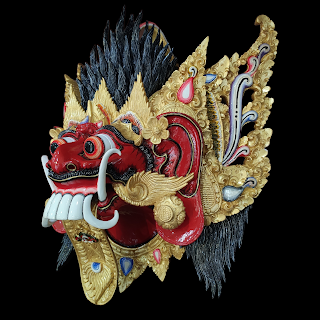Barong the Guardian in Balinese Hindu Belief
Black and white, day and night, light and dark, good and evil are two things that side by side and are inseparable, they are needed by each other to be able to achieve balance. This is stated in the teachings of Hinduism as Rwa Bhineda. Rwa Bhineda can be interpreted as two different things in life which are always one and inseparable. In Balinese Hindu culture this concept is embodied in the form of Barong and Rangda.
Barong is defined in many ways, but in the book "Keberadaan Barong dan Rangda Dalam Dinamika Religius Masyarakat Hindu Bali (The Existence of Barong and Rangda in the Religious Dynamics of the Balinese Hindu Community)" the meaning of Barong is limited as a form of embodiment of Banaspati Raja, namely a magical animal with magical powers which is an incarnation of Lord Shiva when destroying various diseases and distress. This understanding refers to the philosophical understanding (Hindu tattwa) contained in the ejection regarding Barong and Rangda. Because it is an incarnation of Lord Shiva, Barong is used as a sacred figure by Balinese Hindus.
The Barong is manifested in the form of an animal resembling a lion with fur all over its body, bulging eyes, sharp fangs, covered in fire, and its arrival is marked by the sound of tinkling bells.
The story of the Barong is contained in the Shiva Tattwa Lontar which tells the story of Lord Shiva deigning to come down to earth on sasih Kalima to neutralize His wife's power, Goddess Durga. Goddess Durga had descended earlier in the form of Rangda, with the title Sang Hyang Berawi as the God of Murder with her followers such as Bhuta Kala and Pemali. To neutralize Rangda's powers and restore his magical form, Lord Shiva descended to the world in the form of Bhuta Egeg, a type of Bhuta whose form is like Banaspati Raja and resembles the form of Barong. With a frightening form and with the power of truth finally Lord Shiva was able to neutralize evil forces and restore her magical form to become Goddess Uma.
Another story regarding the embodiment of Barong as an incarnation of Lord Shiva is implied in the Lontar Barong Swari. In the story, it is said that Goddess Uma, who was angry because she was cursed by Lord Shiva, became Goddess Durga to the world and doing yoga to the four corners of the compass at Setra Gandamayu. When she was doing yoga facing north, it was gering lumintu, when she was doing yoga facing west, it was gering memancuh, when she was doing yoga facing south, it was gering rung bhuana, and when she was doing yoga facing east, it was gering utah bayar. This causes various diseases and causes the world to be in danger. Seeing the suffering that humanity is experiencing, The Gods felt pity, so Sang Hyang Tri Murti came down to earth and changing form to save humans from the wrath of Goddess Durga. Lord Brahma transformed into Topeng Bang, Lord Vishnu transformed into Telek, and Lord Shiva transformed into Barong.
From these stories, it can be understood why the existence of the Barong is sacred to Balinese Hindu. Barong is one of the figures or manifestations that are worshiped in Balinese Hindu temples, and danced at certain times around the village to fight or neutralize negative forces, and provide protection for all villagers.
Read also : Rangda The Embodiment of The Goddess Durga.
We have many Variant of Barong Mask in Our Shop!
Visit our Etsy Shop :
Get in touch with Us :
Glossary :
B
Barong : A Hindu mythological creature with a shape that is described as resembling a lion, bulging eyes, sharp fangs, and has hair all over its body.
Barong Swari : One of the names of lontar in Balinese Hindu teachings.
Bhuta : Spirits of darkness and evil.
Bhuta Kala : The figure of an evil creature with a scary, fierce face and appears as a seductive creature.
G
Gering : Disease, illness.
L
Lontar : Ancestral heritage texts contain ancient history.
P
Pemali : Ruler of space or place.
R
Rangda : Negative power symbol; The leader of the evil spirits in Balinese Hindu mythology; The incarnation of Goddess Dhurga who served as destroyer.
Rwa Bhineda : The concept of difference in Balinese Hindu teachings is to achieve balance.
S
Sang Hyang Tri Murti : The three forms of God's manifestation power are Brahma as the creator, Vishnu as the preserver, and Shiva as the purifier.
Setra : Cemetery.
Setra Gandamayu : The cemetery which is the starting point of the journey for the spirits to the afterlife.
Sasih Kelima : Period, which in a year sasih consists of twelve sasih. Kelima means fifth.
T
Tattwa : Philosophical thoughts that must be believed to be true.
Sources :
n/d. Wirawan, I Gusti Ngurah. Rwa Bhineda. Institut Seni Indonesia Denpasar. Denpasar.
2021. Wirawan, Komang Indra. Keberadaan Barong dan Rangda Dalam Dinamika Religius Masyarakat Hindu Bali. PT Japa Widya Duta. Denpasar
Author : Ni Kadek Dian Utami Kartini
Editor : I Gusti Putu Adi Febra Nugraha
#balinese #balinesemythology #barong #balinesewoodcarving #barongdance



Comments
Post a Comment